This post may contain affiliate links. Please read our disclosure policy.
Banh Tam Khoai Mi is a unique and delicious Vietnamese dessert made from cassava. Its soft and chewy texture, delicate sweetness, and cultural significance make it a beloved treat enjoyed from kids to adults. It is naturally gluten-free and dairy-free.

What is banh tam khoai mi (silkworm cassava cake)?
Banh means cake, Tam means steamed or cooked, and Khoai Mi means silkworm in Vietnamese. It is a traditional dessert hailing from Southern Vietnam. It is made primarily from cassava, a starchy root vegetable widely used in Vietnamese cuisine. The cakes are usually made in different colors, making them fun to eat and a favorite childhood snacks for many. This traditional dessert holds cultural significance in Southern Vietnam, not only for its flavors but also due to its connection to the region’s silk industry. The cake’s name, resembling the shape of silkworm cocoons, pays homage to the longstanding tradition of silkworm farming in the area.
How is banh tam khoai mi made?
Banh Tam Khoai Mi is made by grating the cassava. The cassava is the mixed with coconut milk, sugar, tapioca starch. The batter is oftened colored red and green separately. The batter is then steamed and cut into strips resembling silk worm. The strips are then rolled into grated coconut and served with toasted sesame seeds and sometimes crushed roasted peanuts.
Banh Tam Khoai Mi (Vietnamese Silkworm Cassava Cake)
Ingredients
If using frozen grated cassava:
- 454 g frozen grated cassava
- 40 g tapioca starch
- 60 g sugar
- ¼ tsp salt
- 100 ml thick coconut milk
If using fresh cassava:
- 600 g peeled cassava get about 1 kg (2.2 lbs) cassava root
- 500 ml water
- 40 g tapioca starch
- 60 g sugar
- ¼ tsp salt
- 100 ml coconut milk
For uncolored batter:
- 30 ml coconut milk from canned coconut milk
- 160 g cassava
For orange batter:
- 30 ml coconut milk from canned coconut milk
- 160 g cassava
- orange food coloring or use any color you like
For purple batter:
- 30 ml coconut milk from canned coconut milk
- 1/16 tsp ube extract or use any color you like
- 160 g cassava
For coating:
- 80 g grated coconut
- ¼ tsp salt
Serve with:
- 3 Tbsp toasted white sesame seeds
- 2 Tbsp sugar
Instructions
Prepare the coconut topping:
- Combine grated coconut and salt. Steam on medium heat for 10 minutes. Let it cool down
If using frozen grated cassava:
- Thaw the frozen grated cassava and squeeze out all the liquid as much as you can after that. Don't throw away the liquid. Let it sit for 10-15 minutes. The drained weight of the grated cassava can be between 380-390 grams
- After the liquid has been sitting for a while, the starch collects at the bottom. Discard the liquid and add the starch back to the cassava. This gives about 410-420 grams of total weight (roughly!)
If using fresh cassava:
- Wear gloves as cassava can be irritating to your skin. After peeling the tough skin of cassava and remove the tough core, get about 600 grams of cassava. You may have some extra left
- Roughly cut into large chunks. Put them in a blender with 500 ml of water and blend them. Pour the mixture over a sieve. You can also transfer it to a cheese cloth. Squeeze out as much liquid as possible. The weight of the cassava after squeezing out the liquid would be roughly about 400 grams (don't have to be exact). Let the liquid sit for 10-15 minutes. The starch will sink to the bottom. Carefully discard the liquid. Add the starch back to the cassava mixture. The total weight is about 420-450 grams (roughly!)
- Combine the cassava with sugar, salt, and coconut milk
Prepare the batter:
- Give the canned coconut milk a shake to mix the cream and the liquid as they usually separate. You can also open up the can and give it a good stir to combine them
- Portion out the cassava into four equal portions, about 150-160 grams each portion. Combine each cassava portion with coconut milk, and color of your choice
Steam the batter:
- Oil the steaming dish to prevent sticking or line it with parchment paper. Spread the batter to about 1/2 inch in thickness
- If you have 3-tier steamer, you can steam them all at the same time. Otherwise, you can also do it like how I did it. I put a few bamboo skewers on top of the plate and then put the second steaming dish on top and then put a few more bamboo skewers on top and stack the last plate on top. This way I can steam all three at the same time
- Wrap the lid of the steamer with a cloth to prevent condensation drops on the surface of the cake. Steam over medium heat for 10-15 minutes. The cake turns slightly translucent and the surface shouldn't be wet
Shaping:
- Let the cake cool down for at least 15 minutes. Use a plastic knife or a plastic bench scraper to cut the cake into strips, about 1 cm thick and roll them in grated coconut to coat evenly
- Combine sesame seeds and sugar in a serving bowl. When ready to serve, portion out some of the cake and sprinkle with the sesame seed and sugar mixture
Storing:
- I recommend storing the cake and the sesame seeds topping separately. Only sprinkle the sesame seeds topping when ready to serve because the sugar in the sesame seed mixture makes the cake wet
RECOMMEDED TOOLS
*Nutrition facts are just estimates and calculated using online tools*
Ingredients and substitutions
1. Cassava
You can use either frozen of fresh cassava. For convenience, I use frozen grated cassava from the grocery store, which has been peeled and grated. This can be easily found in most Asian grocery store.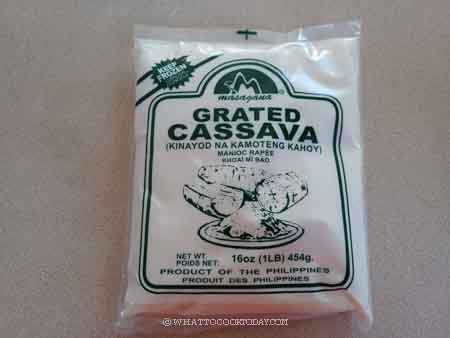
2. Thick coconut milk
I use canned coconut milk. Please don’t use the lite version or the one used as beverage. It’s not suitable for this recipe. The canned coconut milk usually has the cream float to the top and the water is at the bottom. Sometimes it’s a bit hard to shake it to mix. You can stir it after you open the can
3. Tapioca starch
Tapioca starch is added for that extra chewiness to the cake. Sometimes it is called tapioca flour in Asian countries. As long as it is a starch extracted from tapioca, it doesn’t matter if it is called tapioca flour or tapioca starch. Make sure tapioca starch is the only ingredient and nothing else is mixed with it
4. Grated coconut
I usually use frozen grated coconut from the store. I don’t recommend using desiccated coconut because they are less flavorful. But if that’s all you have access to, then use it as a last resort. Just know that it won’t be as flavorful
5. Toasted sesame seeds
White sesame seeds are used. If the sesame seeds have been toasted, you don’t have to toast them anymore
6. Crushed roasted peanuts (optional)
I didn’t use this, but you are welcome to. I love anything with peanuts, and this will add extra texture to the cake too
7. Sugar
I usually use granulated sugar. You can also use caster sugar
8. Salt
I use fine sea salt. Adding a bit of salt rounds up the flavor really well
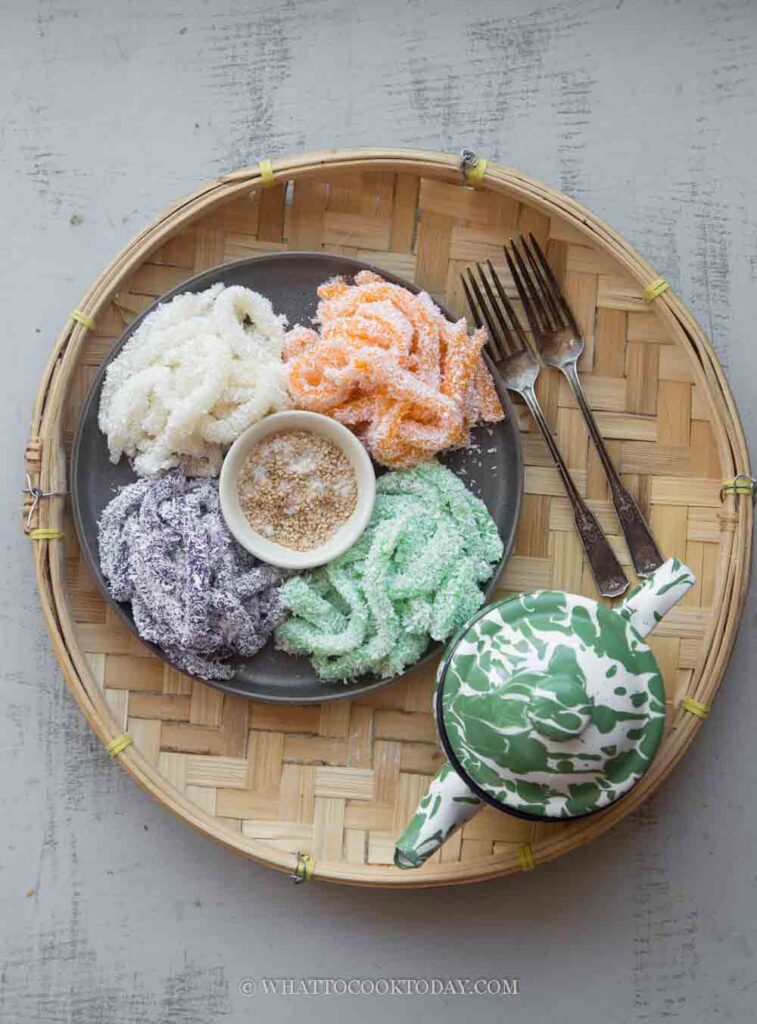
How to make banh tam khoai mi
1. Combine grated coconut and salt. Steam on medium heat for 10 minutes. Let it cool down
2. Thaw the frozen grated cassava and squeeze out all the liquid as much as you can after that. 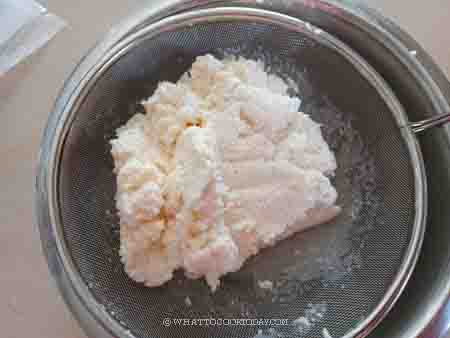
3. Don’t throw away the liquid. Let it sit for 10-15 minutes. The drained weight of the grated cassava can be between 380-390 grams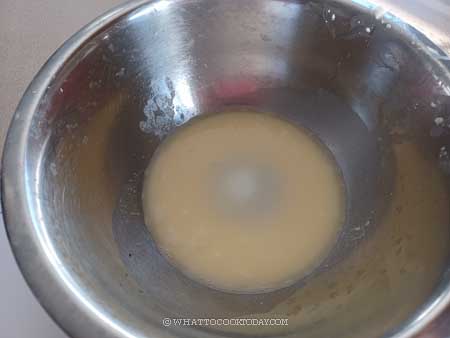
4. After the liquid has been sitting for a while, the starch collects at the bottom. Discard the liquid 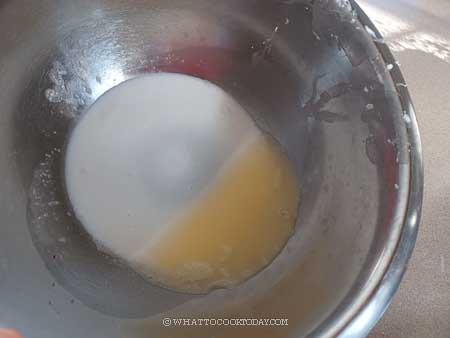
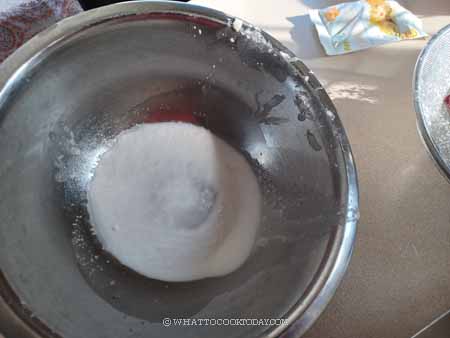
5. Add the starch back to the cassava. This gives about 410-420 grams of total weight (roughly!)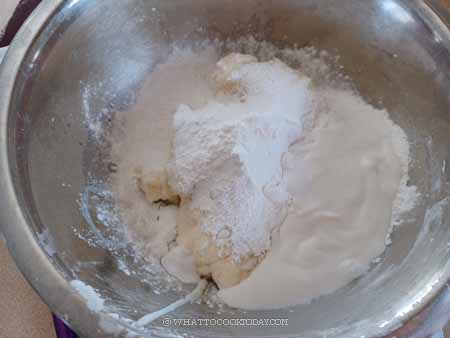
6. Portion the cassava into four equal portions, about 150-160 grams each portion. Combine each cassava portion with coconut milk, and color of your choice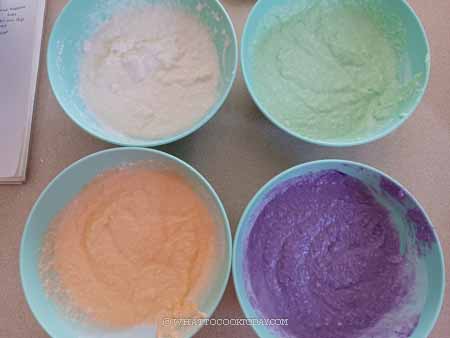
7. Oil the steaming dish to prevent sticking or line it with parchment paper. Spread the batter to about 1/2 inch in thickness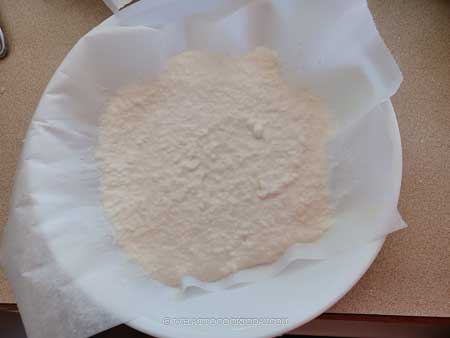
8. If you have 3-tier steamer, you can steam them all at the same time. Otherwise, you can also do it like how I did it. I put a few bamboo skewers on top of the plate and a piece of absorbent paper towel 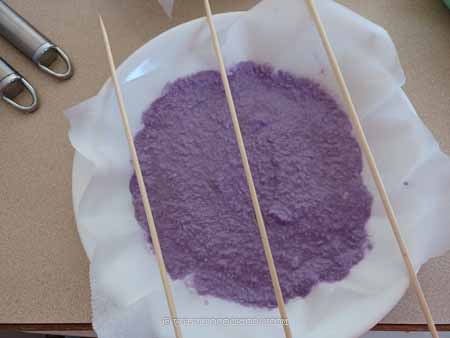
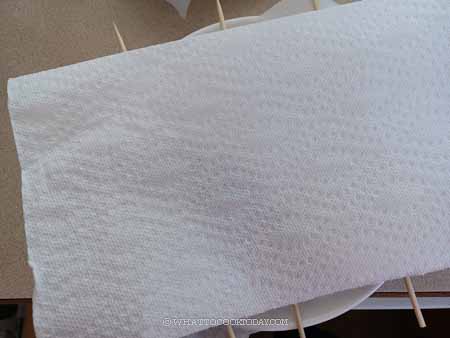
9. Then put the second steaming dish on top and then put a few more bamboo skewers on top and stack the next plate on top followed by an absorbent paper towel. 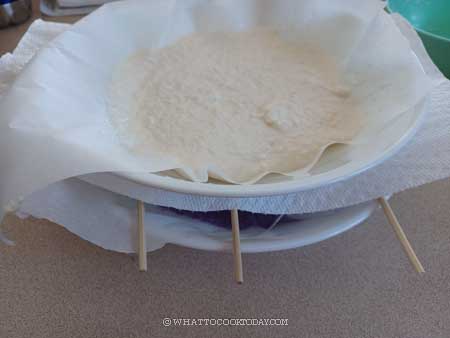
10. This way I can steam at least three at the same time. My steamer can only fit 3 with the way I set it up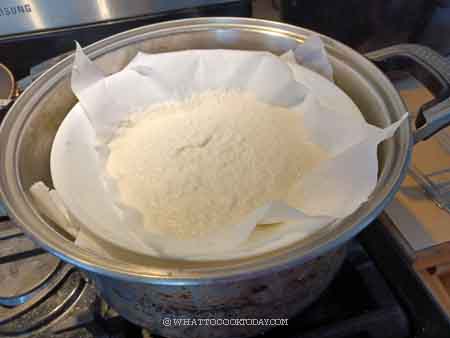
11. Wrap the lid of the steamer with a cloth to prevent condensation drops on the surface of the cake. Steam over medium heat for 10-15 minutes. The cake turns slightly translucent and the surface shouldn’t be wet when it’s done steaming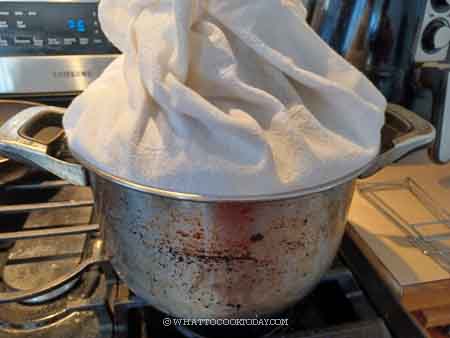
12. Let the cake cool down for at least 15 minutes. Use a plastic knife or a plastic bench scraper to cut the cake into strips, about 1 cm thick and roll them in grated coconut to coat evenly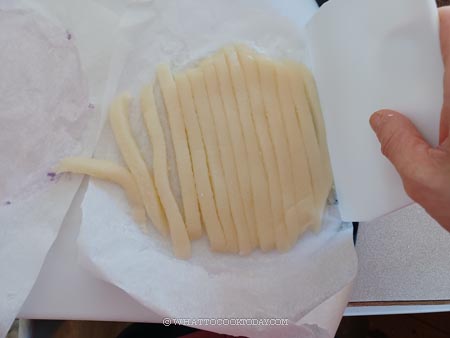
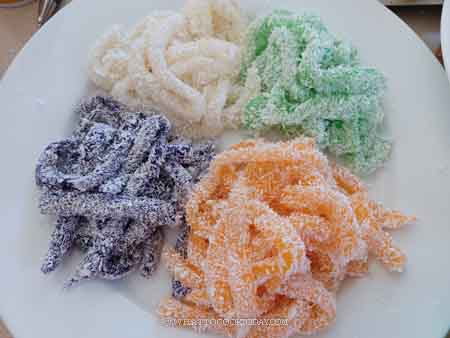
13. Combine sesame seeds and sugar in a serving bowl. When ready to serve, portion out some of the cake and sprinkle with the sesame seed and sugar mixture

Did you make this banh tam khoai mi recipe?
I love it when you guys snap a photo and tag it to show me what you’ve made. Simply tag me @WhatToCookToday #WhatToCookToday on Instagram and I’ll be sure to stop by and take a peek for real!



